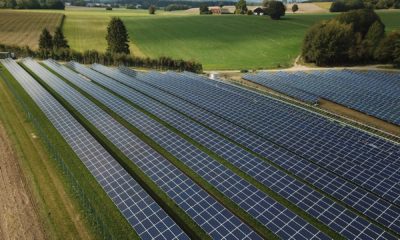Impact Investing
SBTi Publishes Net Zero Standard for the Energy Sector and Opens Consultation
The Science Based Targets initiative (SBTi) released a draft Power Sector Net-Zero Standard, open for consultation until November 3, 2025. Covering generation, transmission, storage, trading, and retail, it replaces the 2020 guide, introduces stricter fossil fuel phase-outs, and aligns with global standards, aiming to guide utilities toward credible, science-based net-zero pathways by 2050.

The Science Based Targets initiative (SBTi) has published the draft Power Sector Net-Zero Standard and launched a public consultation that will remain open until November 3rd, 2025. The new standard aims to provide the electricity sector, responsible for nearly 40% of global energy-related emissions, with a clear, science-based framework to set credible climate targets aligned with the goal of net-zero emissions by 2050.
The electricity sector is in fact at the heart of the transition: on the one hand, it contributes significantly to emissions, on the other, it represents the main enabler of the decarbonisation of other sectors, including transport, industry and construction.
According to the International Energy Agency (IEA), electricity’s share of final energy consumption will increase from 20% in 2023 to over 50% by 2050. This growth affects not only production, but also energy transport and storage, along with the availability of appropriate technologies and skills.
“The decarbonization of the energy sector therefore depends on a broad and diverse ecosystem of actors, from utilities to infrastructure providers, to the world of education and innovation,” the SBTi draft states.
What does the new net zero standard by SBTi for the energy sector entail
The draft of the new SBTi standard will replace the 2020 Quick Start Guide for Electric Utilities , offering a much broader and more detailed approach. Among the main new features are:
alignment with the Corporate Net-Zero Standard V2, ensuring consistent rules for all companies, integrated with specific criteria for the electricity sector;
the extension of the scope of application : the standard considers not only generation, but also transmission and distribution, storage, trading and retailing of energy;
the update of the target-setting methods: pathways based on the IPCC AR6 and IEA NZE 2023 scenarios, with indicators on emission intensity, share of low-carbon electricity and differentiated objectives for value chain activities;
the phase-out of non-abated fossil fuels: that is, the introduction of the obligation to provide transparent plans for the gradual withdrawal of energy capacity generated from coal, oil and gas not equipped with Carbon Capture and Storage (CCS) systems with different timeframes between OECD and non-OECD countries.
Activity-specific metrics , for example, reduction of grid losses for T&D (Transmission & Distribution), use of renewable electricity in trading and retail, criteria for biomass sustainability.
Who is the SBTi Power Sector Net-Zero Standard intended for?
The SBTi Power Sector Net-Zero Standard applies to companies engaged in economic activities related to electricity generation, transmission, and distribution, as well as electricity storage and sales. Specifically:
Electricity generation from low-emission sources, such as renewables (solar, wind, hydroelectric, geothermal), biomass, nuclear, fossil fuels equipped with CCS (Carbon Capture and Storage) systems.
Electricity generation from unreduced fossil fuels (coal, oil, natural gas not equipped with CCS).
Transmission and distribution of electrical energy.
Electricity trade and retail sale (including retail sale of purchased electricity).
Electricity storage.
This standard, the SBTi draft states, is intended for any company globally that operates in one or more of the activities listed above, regardless of whether they represent the core business or not, provided that at least one of the following conditions is met:
GHG emissions from electricity sector activities represent at least 5% of the company’s overall emissions inventory or exceed 10,000 tonnes of CO₂ equivalent;
annual revenues from electricity generation represent at least 5% of total annual turnover.
How to participate in the SBTi standard consultation
The SBTi invites companies, investors, institutions, NGOs, and academics to comment on the draft through an online questionnaire, which can be completed here. The feedback, according to a press release from the international initiative, will be crucial to refining the document, which after this initial phase will be revised, field-tested, and subjected to a second consultation before final approval.
With this standard, the draft ( available here ) states , SBTi aims to provide utilities with a practical and scientifically sound framework for setting climate targets, reducing transition risks, facilitating investment and growth in the global low-carbon electricity market, and harmonizing reporting practices and target validation with common international criteria.
__
(Featured image by Marek Piwnicki via Unsplash)
DISCLAIMER: This article was written by a third party contributor and does not reflect the opinion of Born2Invest, its management, staff or its associates. Please review our disclaimer for more information.
This article may include forward-looking statements. These forward-looking statements generally are identified by the words “believe,” “project,” “estimate,” “become,” “plan,” “will,” and similar expressions. These forward-looking statements involve known and unknown risks as well as uncertainties, including those discussed in the following cautionary statements and elsewhere in this article and on this site. Although the Company may believe that its expectations are based on reasonable assumptions, the actual results that the Company may achieve may differ materially from any forward-looking statements, which reflect the opinions of the management of the Company only as of the date hereof. Additionally, please make sure to read these important disclosures.
First published in ESG NEWS. A third-party contributor translated and adapted the article from the original. In case of discrepancy, the original will prevail.
Although we made reasonable efforts to provide accurate translations, some parts may be incorrect. Born2Invest assumes no responsibility for errors, omissions or ambiguities in the translations provided on this website. Any person or entity relying on translated content does so at their own risk. Born2Invest is not responsible for losses caused by such reliance on the accuracy or reliability of translated information. If you wish to report an error or inaccuracy in the translation, we encourage you to contact us.

-

 Biotech2 weeks ago
Biotech2 weeks agoSpain Joins First EU Joint Clinical Assessment Under New Health Technology Regulation
-

 Crowdfunding1 week ago
Crowdfunding1 week agoa2censo Expands Crowdfunding Access for SMEs and New Investors
-

 Markets5 days ago
Markets5 days agoRice Market Rebounds from Oversold Lows Amid Weak Demand
-

 Markets2 weeks ago
Markets2 weeks agoMixed Market Trends as Global Coffee Growing Conditions Improve

























